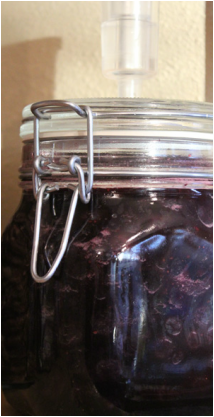
(adapted from Nourishing Traditions)
A delicious, healthful substitute for pancake syrup and ice cream topping! Try with Probiotic Ice Cream! (coming soon!) Ready to Eat: two days Ingredients: 8 cups (2 lbs) fresh or frozen blueberries, raspberries, or any berry except strawberries, or a mixture of berries 24 grams Himalayan Pink Salt (4 tsp) 100 grams of Rapadura, or other whole sugar Jar: 1 Liter Brine: not applicable Ferment: 48 hours Temperature: 68-72ºF
Preparation:
1. Set aside 1 cup of berries. 2. Allow frozen berries to thaw. 3. In a medium bowl, mash or puree enough remaining berries to create liquid to cover the berries, down to about 4 cups or so. 4. Stir salt and sugar into berries. 5. Pour berries into Probiotic Jar halfway between shoulder and neck, adding berries set aside as needed (pour berries out and stir in, then pour back into Jar to get the volume just right). 6. Float the Brine Bowl, pressing the berries under and causing the brine to rise. 7. Lock the Jar, fill the Airlock with water, and twist the Airlock into place. 8. Place in a dark spot at 72ºF for 48 hours, then move to the refrigerator and eat! Note: It is reassuring to know that in an anaerobic vessel that everything we create, even when not as expected, will be safe to eat, as long as the vegetables/fruit are raw. While the blueberries didn't turn out as expected, they would not have harmful bacteria in them. I purchased frozen organic blueberries from Costco, and they were clearly alcoholic when finished. I gave them to someone who loves to mix blueberries in liquor, and made another batch with frozen organic store brand Fred Meyer blueberries. They turned out wonderfully, and I did everything exactly the same way.
13 Comments
Candace
2/4/2015 09:12:11 pm
After 2 days on the counter my syrup is very salty. Is it really 70 grams of salt? Thinking maybe I just need to leave it longer?
Reply
The Probiotic Jar
2/28/2015 11:07:04 pm
Hello Candace,
Reply
Candace
3/1/2015 07:42:40 am
No worries! I am excited to try it again!
Andrea
3/20/2016 05:46:25 pm
I'm curious. I thought you could not ferment fruits without the addition of a culture such as whey. I know you can ferment vegetables without culture, but I had heard that fruits would just turn into alcohol. Can anyone clarify? Thanks!
Reply
Sarah
3/25/2016 05:22:48 am
Adding whey (dairy) to a fruit ferment disrupts the healthy fermentation process by adding the wrong bacteria and lowering the pH. It is useful if you don't have an anaerobic vessel to inhibit mold, but it also causes the ferment to skip the first stage of fermentation because of the pH change. http://www.probioticjar.com/whats-happening-in-the-jar.html
Reply
Andrea
4/18/2016 01:32:31 am
So, is it safe to use the Costco frozen blueberries then? Will they still ferment even after being frozen? I saw the note on the bottom saying that frozen blueberries didn't work, but then in the comments it's looks like that may have been due to an incorrect amount of salt? Could I use frozen blueberries and just add a starter culture made for use with fermenting veggies? Thanks!!
Reply
Karen
4/18/2016 09:41:04 pm
Hi Andrea,
Reply
Andrea
4/19/2016 01:55:08 pm
Awesome, thanks Karen!
Deidre
5/16/2017 02:46:17 pm
Why not strawberries?
Reply
Karen
5/29/2017 03:13:17 pm
Hi Deidre,
Reply
Michelle Johnson
9/2/2018 06:10:27 pm
I made this exactly as recipe stated... mine just tastes salty... it’s in the fridge now...anyway to fix this?
Reply
Lilly
9/4/2019 12:43:37 pm
Can I substitute frozen figs? Can I use coconut sugar?
Reply
Leave a Reply. |
Recipe ListHere you will find the most delicious, health-boosting concoctions on planet earth! You are sure to experience both a delightful sensation on your taste buds as well as a happy tummy!
Beets, (Grated) with Clove, Cinnamon & Allspice Beet Kvass Brussel Sprouts Berry Syrup/Sauce Carrots (Grated) with Chocolate Mint Cabbage Juice Carrots & Beets with Rosemary & Thyme Carrot Sticks (Herbed or Plain) Carrot (Grated) with Chocolate Mint Carrots, Leeks, Ginger & Dill Dandelion Buds Dill Pickles (Traditional) Fire Cider Garden Medley Kvass Garlic Ginger, Shaved & Pickled Ginger, Beet & Kale Kvass Ginger Soda Ginger Bug (Starter) Granola Green Beans Lemons Mayonnaise Ranch Dressing Salsa ~ Chunky Tomato Sauerkraut Sauerkraut Juice Turmeric Root Tonic ~ Cold, Sinus & Flu Categories
All
How ToThe success of every recipe shared on this site is dependent on the proper application of anaerobic pickling techniques. These recipes are designed specifically to work in The Probiotic Jar. Please follow the instructions in the Quick Start Guide when creating these recipes. Archives
January 2016
|
 RSS Feed
RSS Feed
